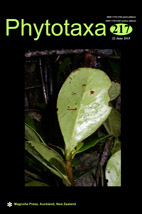Abstract
Molecular phylogenetic analyses, morphological observations, and nomenclatural studies were carried out to investigate the taxonomic status of Portulaca boninensis, endemic species from the Bonin (Ogasawara) Islands (Japan). The results addressed controversy between the widely naturalized P. boninensis and P. pilosa, indicating that they are phylogenetically and morphologically distinct. Furthermore, P. boninensis was showed to be conspecific to P. psammotropha which is until now recorded in southern China, Taiwan, and the northern Philippines, but not in the Ryukyus. The name of P. psammotropha was lectotypified on a specimen preserved at K. Based on phylogeography, P. psammotropha likely migrated to the Oceanic Bonin Islands oversea by sea-current dispersal or by exo- and/or end ozoochory through migratory birds without passing through Ryukyus.

